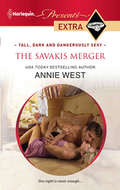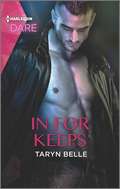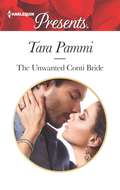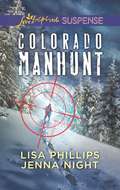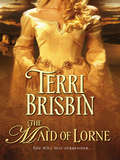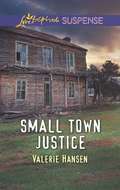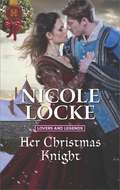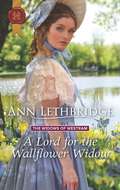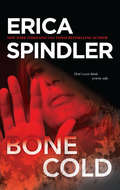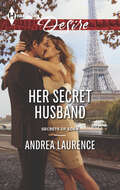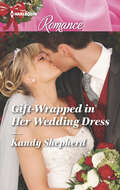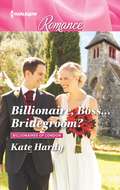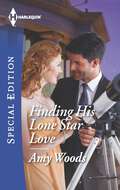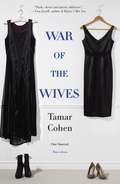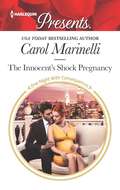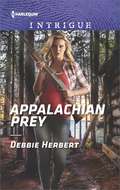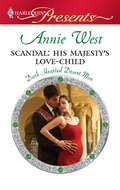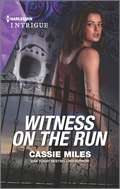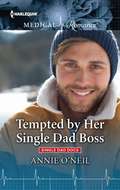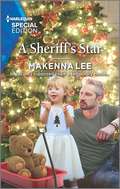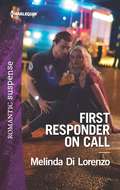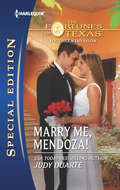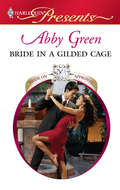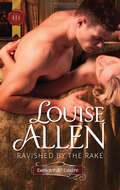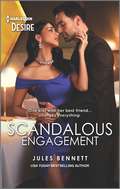- Table View
- List View
The Savakis Merger (Tall, Dark and Dangerously Sexy #1)
by Annie WestOnly hours ago she was a wickedly tempting, sexy stranger. Now Damon Savakis knows who she really is-Callie Manolis, society ice-queen and duplicitous niece of his arch enemy.Yet when Callie's avaricious uncle loses the Manolis money, she becomes the bargaining chip in the Savakis merger! Damon is unprepared for her bravery, poise and purity in a world full of greed. Once she's paid her dues in his bed...he'll make her his willing bride for free!
In For Keeps: A Holiday Fling Romance (Tropical Heat #2)
by Taryn BelleKiki’s sexy one-night stand with rock god Dev Stone has become a red-hot affair with a lot of potential…until she discovers a secret that threatens to ruin everything.Kiki Becker moved to Moretta—a beautiful island and popular celebrity haunt—to escape a painful divorce. But after a scorching one-night stand with rock star Dev Stone almost becomes a sex scandal, she realizes she needs to face real life again. When Dev offers her a job as his tour assistant, Kiki leaps at the chance to go to Australia and find the mother who abandoned her decades ago.Dev can’t stop thinking about his electrifying night with Kiki, so he’s thrilled when she accepts. Their chemistry is irresistible, and the pair soon embark on a sexy no-strings affair—the perfect distraction from his tiresome celebrity life and all its trappings.Kiki realizes she’s falling for Dev and cautiously confides in him about her past, bringing the couple closer together. But Dev has his own dark secret and it could push Kiki away forever. Will he trust her with it…or walk away and break her heart before she can break his?The Tropical Heat series:In Too DeepIn For KeepsIntoxicatedStep into stories of provocative romance with Harlequin DARE, where sexual fantasies come true. Let your inhibitions run wild. Four new Harlequin DARE titles are available each month, wherever ebooks are sold!
The Unwanted Conti Bride: The Billionaire's Ruthless Affair Moretti's Marriage Command The Unwanted Conti Bride The Flaw In Raffaele's Revenge (The Legendary Conti Brothers)
by Tara Pammi"I want to marry you." If Sophia Rossi wants to save her father's business, then merging the Rossi and Conti empires is the only way. Luca Conti broke her heart once before, but this time Sophia's in the driver's seat. Except Luca can still make her body tremble with just a look! Luca has spent years cultivating his Conti Devil reputation to mask the darkness he inherited from his father, a facade that Sophia should be all too familiar with. Still, the shrewd businessman can see the benefits of her proposal... He might not want her as his bride, but he'll enjoy having her in his bed!
Colorado Manhunt: Wilderness Chase / Twin Pursuit (Mills And Boon Love Inspired Suspense Ser.)
by Lisa Phillips Jenna NightFugitives on the lam…And danger in the mountain wilderness.In Wilderness Chase by Lisa Phillips, US marshal Noah Trent will do anything to protect key witness Amy Sanders when the brother she testified against escapes from prison and comes after her in the Rocky Mountains. And in Jenna Night’s Twin Pursuit, bounty hunter Lauren Dillard must battle the mountain elements and trained killers when she mistakenly tracks her target’s twin brother, Jason Cortez.
The Maid of Lorne
by Terri BrisbinAs heiress to the MacDougall clan,Lara, Maid of Lorne, knows that when she marries itwill not be for love—but never dreams it will be used aspunishment. When Robert the Bruce takes control ofher castle home, Lara is forced to wed the Bruce's man,Sebastien of Cleish. Loyal to her clan, she vows she willnot surrender to this bold warrior.But beneath his chain mail and armor lies theheart of a chivalrous, brave knight willing to entice, towoo, to make Lara his true wife—in every way. Couldthe man who stole her virtue, her home andher family give her a future in his arms?
Small Town Justice: A Riveting Western Suspense
by Valerie HansenDANGEROUS SECRETS Back home in Serenity, Jamie Lynn Henderson's determined to prove her brother was framed for the town sheriff's hit-and-run death years ago. But as she encounters dead end after dead end, Jamie Lynn discovers someone will go to any lengths-even murder-to bury the evidence. Her only hope of staying alive long enough to uncover the truth is Shane Colton, the late lawman's wary son. Shane's world was shattered by one senseless act that he can't forgive. But somehow he is drawn to protect the lovely woman trying to free her brother from prison. If they don't work fast, Jamie Lynn's single-minded quest might lead them both into the killer's trap.
Her Christmas Knight: The Wallflower's Mistletoe Wedding Her Christmas Knight The Hired Man (Lovers and Legends #6)
by Nicole LockeA knight to protect her—this YuletideBy order of the English king, Alice of Swaffham searches London nobility for the traitor dealing information to the Scots. Little does she know that the mysterious spy she seeks is the man she once loved and thought she’d lost forever…If Hugh of Shoebury felt unworthy of Alice before, as the Half-Thistle spy he can never claim her heart. Now he must fight to keep not only his dark secrets—and Alice—safe from a vengeful king…but also his burning longing for her at bay!
A Lord for the Wallflower Widow (The Widows of Westram #1)
by Ann LethbridgeUntouched and alone…could he awaken her senses?Part of The Widows of Westram When widow Lady Carrie meets charming gadabout Lord Avery Gilmore, she is shocked by her intense reaction to him. She’s never before longed for wifely pleasures, and it takes all of her courage to propose that he show her them! He might be taken aback by her request, but as Carrie learns firsthand, this lord will take the challenge very seriously…The Widows of Westram miniseries Book 1 — A Lord for the Wallflower Widow Look out for the next story, coming soon!“Ann Lethbridge’s talent for penning deliciously naughty and smart love stories shines... A zippy, delightful read” — RT Book Reviews on Rescued by the Earl’s Vows“A charming, highly romantic story filled with engaging characters” — RT Book Reviews on An Innocent Maid for the Duke
Bone Cold: All The Pretty Girls A Perfect Evil Bone Cold
by Erica SpindlerTwenty-three years ago Anna North survived a living nightmare. A madman kidnapped her, cut off her pinkie, then vanished. Today Anna lives in New Orleans, writing dark thrillers under another name. She finally feels safe.Suddenly Anna's quiet life takes a frightening turn. Letters start to arrive from a disturbed fan. Anna is followed, her apartment broken into. Then a close friend disappears.Anna turns to homicide detective Quentin Malone, but Malone's more concerned with the recent murders of two women in the French Quarter. But after a third victim is found-a redhead like Anna, her pinkie severed-Malone is forced to acknowledge that Anna is his link to the killer...and could be the next target.Now Anna must face the horrifying truth-her past has caught up with her. The nightmare has begun again.
Her Secret Husband: Stranded With The Rancher Her Secret Husband A High Stakes Seduction (Secrets of Eden #2332)
by Andrea LaurenceLove, honor—and vow to keep the marriage a secret!Years ago, Heath Langston eloped with Julianne Eden. Their parents wouldn't have approved. So when the marriage remained unconsummated they went their separate ways without telling anyone what they'd done.Now family turmoil forces Heath and Julianne back into the same town—into the same house. Heath has had enough of living a lie. It's time for Julianne to give him the divorce she's avoided for so long—or to fulfill the promise in her smoldering glances and finally become his wife in more than name only.Be sure to read other scandalous stories from the Secrets of Eden series by Andrea Laurence, only from Harlequin® Desire!UNDENIABLE DEMANDSA BEAUTY UNCOVEREDHEIR TO SCANDAL
Gift-Wrapped in Her Wedding Dress (Sydney Brides #1)
by Kandy ShepherdThe billionaire's Christmas proposal... Billionaire Dominic Hunt's Christmas ball is a chance for hard-working party planner Andie Newman to make her name. She's intent on convincing gorgeous Dominic that decking the halls is the way to transform his brooding reputation, but he has an alternative idea-a festive proposal! After Dominic unexpectedly helps Andie with her own emergency, she says yes! The engagement is meant to be just for show, but as Dominic and Andie are surrounded by the magic of Christmas, they find their fake feelings are becoming all too real...
Billionaire, Boss...Bridegroom?: A Billionaire Romance (Billionaires of London #1)
by Kate HardyThe boss's proposal Gorgeous, rich CEO Hugh Moncrieff might be his office's reluctant heartthrob, but he does not date employees! Until he needs a fake date for an upcoming engagement and decides his quirky new graphic designer Bella Faraday is the perfect candidate... Except Bella is anything but the unsuitable girlfriend she's supposed to be playing! Charming Bella's life might have been shattered by her ex, but with Hugh she feels all the pieces starting to fit back together...
Finding His Lone Star Love
by Amy WoodsYou have a daughter... Those words from a long-ago fling changed restaurateur Sam Haynes's life forever. But when he finds his child in Peach Leaf, Texas, Sam gets more than he bargained for. Headstrong Shiloh and her beautiful aunt, Lucy Monroe, are a package deal-one that Sam is more than happy to accept. Observatory manager Lucy doesn't believe in out-of-this-world romances. The only star in her life is her handicapped niece, Shiloh. So, when mysterious Sam shows up in Peach Leaf, Texas, Lucy is on guard. The last thing she needs is a man in her life. But her heart melts as Sam bonds with Shiloh, making her wonder if the stars might align for her very own happily-ever-after...
War of the Wives
by Tamar CohenThink marriage means happily-ever-after? Think again... Selina and Lottie are complete opposites. Where Selina is poised but prudish, Lottie is quirky and emotional. Selina is the dutiful mother of three children and able manager of their stylish suburban home. Lottie lives with her eccentric teenage daughter in a small city apartment fit to bursting with color and happy chaos. But these women also have one shocking similarity: they're married to the same man...and they've just found out he's dead. Selina has been married to Simon Busfield for twenty-eight years, Lottie for seventeen. Neither knows a thing about the other until the day of Simon's funeral, where the scandalous truth is revealed in front of everyone they know. Another wife, another family... And they've onlyjust scratched the surface of Simon's incredible betrayal. With dark humor and razor-sharp wit, Cohen expertly unravels a story of deception and betrayal, where two very different families will discover they are entwined in ways that will change them all forever. "Witty, ludicrously melodramatic and psychologically perceptive." -Sunday Telegraph "A cracking debut.... Fatal Attraction with a clever twist at the end. Addictive." -The Bookseller on The Mistress's Revenge
The Innocent's Shock Pregnancy: A Passionate Pregnancy Romance (One Night With Consequences #4)
by Carol MarinelliShe gave him her innocence…Now she’ll be his convenient bride!Wherever ruthless billionaire Ethan Devereux goes, the press follow. So when he discovers the astonishing night he shared with talented actress Merida ended in pregnancy, he moves fast to contain the scandal. Suddenly Merida lands the biggest role of her career—playing the part of the loving Mrs. Devereux. But she knows the real challenge is pretending she can walk away from their electric chemistry…“Ms. Marinelli has delivered an absolutely riveting read in this book where emotions run high, the sexual tension between this couple builds and builds until it spills over onto the pages wonderfully in nicely-detailed romantic moments” —Harlequin Junkie on Claiming His Hidden Heir“A lovely, atmospheric, and touching romance” —Goodreads Reader on Captive for the Sheikh’s Pleasure
Appalachian Prey: Secured By The Seal (red, White And Built, Book 5) / Ranger Defender (texas Brothers Of Company B, Book 2) (Lavender Mountain #1)
by Debbie HerbertStar-crossed lovers on Lavender Mountain…Danger awaits them both.After her father’s murder, pregnant Lilah Tedder dreads facing deputy Harlan Sampson, her child’s secret father, who left her heartbroken. Though she still wants him, Lilah knows his professional ambition won’t let him associate with a moonshiner’s daughter. But when a killer targets Lilah, Harlan becomes more than her protector. Now they must uncover old family secrets or pay the ultimate price.
Scandal: His Majesty's Love-child (Dark-Hearted Desert Men #4)
by Annie WestSpeculation surrounding exiled rebel Prince Tahir Al'Ramiz has reached fever pitch! After being spotted causing mayhem in an exclusive Monte Carlo casino, Tahir decides to fly home for his brother's coronation. But when the remains of his helicopter are discovered, the worst is assumed…. Until he comes back from the dead, with no explanation as to how he survived!Now a mysterious beauty has moved into the palace. Rumors of a pregnancy abound…. Could it be that this notorious playboy prince's lost days in the desert camouflaged a secret affair?
Witness on the Run
by Cassie MilesAnswers are hidden in her past,But can she unravel the clues before she’s killed?Amid the revelry of a New Orleans parade, WITSEC’s Alyssa Bailey is nearly abducted before investigator Rafe Fournier comes to her defense. Although she’s unsure who she can trust, Alyssa turns to Rafe to help her investigate. Racing around the Quarter to escape whoever has discovered her whereabouts, they soon learn what truths hide in the past. And they’re more dangerous than anything Alyssa could have ever imagined…USA TODAY Bestselling Author
Tempted by Her Single Dad Boss: Fall in love with this single dad romance! (Single Dad Docs #1)
by Annie O'NeilHer off-limits boss…Is worth breaking the rules for!In this Single Dad Docs story, physiotherapist Maggie Green’s instant attraction to her buttoned-up new boss Dr. Alex Kirkland might be against the rules, but since becoming an amputee she’s determined to live life to the full — including embarking on a fling! As their chemistry intensifies, Alex and his adorable son’s acceptance of Maggie for who she is, makes her long for something she never thought possible…a family.Single Dad Docs quartetBook 1 — Tempted by Her Single Dad Boss by Annie O’NeilBook 2 — Resisting Her English Doc by Annie ClaydonLook out for the next two books, coming soon:Book 3 — The Single Dad’s Proposal by Karin BaineBook 4 — Nurse to Forever Mom by Susan Carlisle“Both the main characters were fascinating and I loved their back stories, as they’re so different, and yet, they’re so great together.” Harlequin Junkie on One Night with Dr Nikolaides “Annie O’Neil is a master of her craft when it comes to feeling what her characters feel and the whole mix together is what made me adore this story.” Goodreads on Reunited with Her Parisian Surgeon
A Sheriff's Star (Home to Oak Hollow #1)
by Makenna LeeIt was only supposed to be a temporary home…He interrupts her plans… When police chief Anson Curry returns a lost little girl to her frantic mother, his only goal is to ease the single mom’s anxiety. But it doesn’t take long for Tess Harper’s amazing child to have Anson wrapped around her little finger—and for Tess to have him thinking about a possible relationship. As for Tess, she’s tempted—even though she had planned to be in Oak Hollow, Texas, only temporarily. But after losing her father and brother in the line of duty, Tess thinks Anson’s job poses too much of a risk to her heart. And Anson has no plans to get involved with someone who’s planning on leaving. From Harlequin Special Edition: Believe in love. Overcome obstacles. Find happiness.Home to Oak HollowBook 1: A Sheriff’s Star
First Responder on Call (Mills And Boon Heroes Ser. #2)
by Melinda Di LorenzoShe doesn’t remember her nameBut she knows her child is in danger…When Remo DeLuca stumbles on a mysterious, injured woman, the EMT springs into action to save her. Celia Poller doesn’t know who she is—the only thing she’s sure of is that she and her child are in danger! With so many unknowns between Remo and Celia, it’s no time for love, especially when someone wants them both dead and gone…
Marry Me, Mendoza! (The Fortunes of Texas: Southern Invasion)
by Judy DuarteSecond-chance sweethearts?Nicole Castleton was a shrewd businesswoman with a Texas-sized stubborn streak. She needed a husband in a hurry, and no one but her ex, Miguel Mendoza, would do! Yet she had her doubts-sweet, sexy Miguel still shook her to the core of her expensive Castleton boots. And when it came right down to it, she still desired the man beyond words.Was it a ghost standing on his doorstep? Or could this really be his Nicole? The girl who broke Miguel's heart ten years ago was back-with a crazy proposal for a strictly business marriage! A desire for payback-and one last round of romance with the one who'd gotten away-tempted Miguel beyond any dollar amount. But this time, he wasn't so sure he'd be able to walk away from the woman of his dreams....
Bride in a Gilded Cage: A Billionaire and Virgin Romance (Bride on Approval)
by Abby GreenThe tango is an Argentinean dance of possession and passion...and that's exactly how aristocrat Rafael Romero intends his convenient marriage to teacher Isobel will be. First he will take her as his bride. Then he'll lead her to the marriage bed, where he'll make her his.Isobel may have no choice but to give her hand to Rafael in matrimony, yet she intends to stay as free as a bird. But her new husband will keep her caged once he discovers he's wed a virgin....
Ravished by the Rake: A Regency Historical Romance (Danger & Desire #1)
by Louise AllenVivacious lady Perdita Brooke prides herself on her social poise...except when faced with devastatingly dashing Alistair Lyndon. The dreamy young man Dita once knew is now a hardened rake, who clearly does not remember their passionate night together...however much it's emblazoned on her memory!Now Dita has the perfect opportunity to remind Alistair of their sizzling chemistry. But soon she is in over her head. Provoking him is supposed to be a deliciously wicked game, with her holding all the cards-until Alistair reveals the ace up his sleeve!
Scandalous Engagement: Scandalous Engagement (lockwood Lightning) / Back In His Ex's Bed (murphy International) (Lockwood Lightning #3)
by Jules BennettDelve into this scandalous friends-to-lovers romance, part of the Lockwood Lightning series from USA TODAY bestselling author Jules Bennett.Their engagement may be fake but the chemistry is as real as it gets! Especially when one kiss with her best friend… changes everything.Josie Coleman has the perfect plan to get rid of her bothersome ex-husband: pretend she&’s about to marry again. But her fake engagement to her best friend, Reese Conrad, isn&’t going as expected. His steamy, toe-curling kisses are anything but friendly…and their simple plan leads to very complicated feelings. Too bad that isn&’t the only surprise Reese has in store…From Harlequin Desire: A luxurious world of bold encounters and sizzling chemistry.Lockwood Lightning:Book 1: An Unexpected ScandalBook 2: Scandalous ReunionBook 3: Scandalous Engagement
